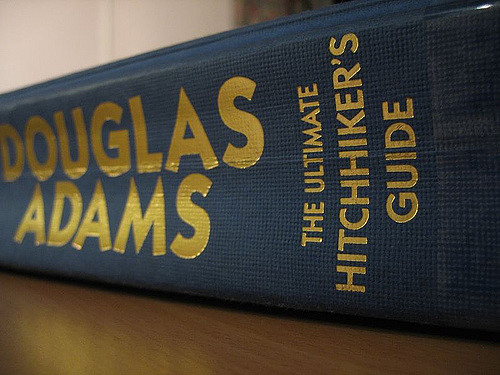February 26, 2020
Meaning of Life
at least, the meaning of meaningful
Humans like to ask questions
Childs are always asking Why?
- and Why?
- and Why?
- and Why?
- and Why?
Until when?
What is the ultimate answer?
The Answer to the Ultimate Question of Life, the Universe, and Everything
According to The Book
The Hitchhiker’s Guide to the Galaxy
something like this…

42 what?
- Hyper-intelligent beings create a computer to find the Answer to the Ultimate Question of Life, the Universe, and Everything
- This enormous supercomputer (of the size of a city) calculated during 7.5 million years
- Unfortunately, no one knows what the question is
- To calculate the Ultimate Question, a special computer the size of a planet was built from organic components and named Earth
- After ten million years of calculation, the Earth is destroyed five minutes before the computation is complete
I will not take that risk
I don’t want to destroy the Earth
So, let’s instead say …
24
24 what?
24°
24 degrees of what?
Angle? Latitude? Temperature?
- Celsius?
- Fahrenheit?
- Kelvin?
There is a big difference. For example 24°F=-4.44°C=268.706K
Do we have meaning now?
24°C
Is this good or bad?
Depends
- If it is a human body, it is bad
- It is probably a dead body
- If it is the weather, then it is good
Shall we get more data?
Ok, Now we have 100 temperature values
24.01, 24.66, 22.93, 19.92, 15.72, 12.4, 9.918, 8.99, 9.288, 11.96, 16.01, 20.86, 23.95, 24.65, 22.87, 19.81, 15.89, 12.12, 9.86, 8.755, 8.845, 11.34, 15.47, 20.5, 23.99, 24.85, 23.04, 20.23, 16.3, 12.44, 9.89, 8.703, 9.105, 11.36, 15.83, 20.59, 23.81, 24.56, 23.07, 19.9, 15.86, 12.14, 9.805, 8.89, 9.193, 11.75, 15.95, 20.62, 23.95, 24.81, 22.96, 19.51, 15.81, 12.31, 9.678, 8.665, 9.178, 11.48, 15.62, 20.51, 24, 24.81, 23.03, 19.68, 15.99, 12.3, 10.11, 9.01, 9.348, 11.76, 15.91, 20.54, 24.25, 24.7, 23.37, 19.83, 15.27, 11.79, 9.6, 8.693, 9.04, 11.64, 15.93, 20.81, 23.97, 24.52, 22.79, 19.84, 15.96, 12.38, 9.97, 8.818, 9.355, 11.62, 16.09, 20.68, 23.79, 24.57, 23.13, 19.73 and 15.61
Do you see any meaning? Any pattern?
There are patterns
Essence v/s accident
Clustering
Now you have a better story
hot, hot, hot, warm, mild, cold, cold, cold, cold, cold, mild, warm, hot, hot, hot, warm, mild, cold, cold, cold, cold, cold, mild, warm, hot, hot, hot, warm, mild, cold, cold, cold, cold, cold, mild, warm, hot, hot, hot, warm, mild, cold, cold, cold, cold, cold, mild, warm, hot, hot, hot, warm, mild, cold, cold, cold, cold, cold, mild, warm, hot, hot, hot, warm, mild, cold, cold, cold, cold, cold, mild, warm, hot, hot, hot, warm, mild, cold, cold, cold, cold, cold, mild, warm, hot, hot, hot, warm, mild, cold, cold, cold, cold, cold, mild, warm, hot, hot, hot, warm and mild
Lower precision gives more meaning
Look how it changes with time
You can see a 12-month period
Levels of Knowledge
We can distinguish several levels on this story

Data versus Information
Our instruments produce Data. A lot, cheaper every day
Information is the abstraction of data that allows us to make decision
Knowledge allows us to explain why things are as we see
Wisdom allows us to predict the future
Let us look inside these categories
Data: How do we observe
Psychologist Stanley Smith Stevens proposed a taxonomy of Levels of Measurement
- Nominal scale
- Ordinal scale
- Interval scale
- Ratio scale
Stevens, S.S. (1946). On the Theory of Scales of Measurement. Science, 103 2684, 677-80.
Nominal scale
- Qualitative
- Assigning names to things
- Group similar things together
- Taxonomies
- Ontologies
- Mathematical operations: test for equality, test for set membership
- Central tendency: mode
Ordinal scale
- Semi qualitative, Rank
- Example: ‘completely agree’, ‘mostly agree’, ‘indifferent’, ‘mostly disagree’, ‘completely disagree’
- There is order, but intervals can be different
- Real differences between adjacent ranks may not be equal
- Mathematical operations: less-than, sort
- Central tendency: median
- And all the properties of Nominal
Interval scale
- degree of difference between items, but not the ratio between them
- Examples
- Temperature in the Celsius scale
- date when measured from an arbitrary epoch (such as AD)
- location in Cartesian coordinates
- direction measured in degrees from north
- Mathematical operations: Plus, Minus, ratio of differences
- Central tendency: arithmetic mean, standard deviation
Ratio scale
- Has a meaningful (unique and non-arbitrary) zero value
- Most measurements in physical sciences and engineering
- mass, length, duration, plane angle, energy, and electric charge
- values have units of measurement
- Mathematical operations: multiplication, division
- Central tendency: geometric mean, harmonic mean, coefficient of variation
Alternative: Mosteller and Tukey’s typology (1977)
- Names
- Grades (ordered labels like beginner, intermediate, advanced)
- Ranks (orders with 1 being the smallest or largest, 2 the next smallest or largest, and so on)
- Counted fractions (bound by 0 and 1)
- Counts (non-negative integers)
- Amounts (non-negative real numbers)
- Balances (any real number)
Chrisman’s typology (1998)
- Nominal
- Gradation of membership
- Ordinal
- Interval
- Log-interval
- Extensive ratio
- Cyclical ratio
- Derived ratio
- Counts
- Absolute
Summary of “Levels of Measurement”
| Incremental progress | Measure property | Mathematical operators | Advanced operations | Central tendency |
|---|---|---|---|---|
| Nominal | Classification, membership | =, ≠ | Grouping | Mode |
| Ordinal | Comparison, level | >, < | Sorting | Median |
| Interval | Difference, affinity | +, − | Yardstick | Mean, Deviation |
| Ratio | Magnitude, amount | ×, / | Ratio | Geometric mean, Coefficient of variation |
Wikipedia: Levels of Measurement
Levels of Knowledge
Bloom’s Taxonomy of Knowledge (1956)
These categories are used for teaching and education research
- Knowledge
- Comprehension
- Application
- Analysis
- Synthesis
- Evaluation
Bloom’s Taxonomy (1956)
- Knowledge “involves the recall of specifics and universals, the recall of methods and processes, or the recall of a pattern, structure, or setting.”
- Comprehension “refers to a type of understanding or apprehension such that the individual knows what is being communicated and can make use of the material or idea being communicated without necessarily relating it to other material or seeing its fullest implications.”
Bloom’s Taxonomy (1956)
- Application refers to the “use of abstractions in particular and concrete situations.”
- Analysis represents the “breakdown of a communication into its constituent elements or parts such that the relative hierarchy of ideas is made clear and/or the relations between ideas expressed are made explicit.”
Bloom’s Taxonomy (1956)
- Synthesis involves the “putting together of elements and parts so as to form a whole.”
- Evaluation engenders “judgments about the value of material and methods for given purposes.”
Bloom’s Revised Taxonomy (2001)
- Remember
- Understand
- Apply
- Analyze
- Evaluate
- Create
Bloom’s Revised Taxonomy (2001)
- Remember
- Recognizing
- Recalling
- Understand
- Interpreting
- Exemplifying
- Classifying
- Inferring
- Comparing
- Summarizing, Explaining
Bloom’s Revised Taxonomy (2001)
- Apply
- Executing
- Implementing
- Analyze
- Differentiating
- Organizing
- Attributing
Bloom’s Revised Taxonomy (2001)
- Evaluate
- Checking
- Critiquing
- Create
- Generating
- Planning
- Producing
Explanations
The key question is “Why”?
How can we explain the temperature changes?
- God’s will
- Magic
- Just good luck
- Movement of the planet
- Witchery
The meaning is on the explanation
In a broad sense an explanation is a story
At some level any story is valid
Human mind apparently is a storyteller
To be meaningful you have to tell a story
The meaning of life
Your life is meaningful…
… if at the end of the day you can tell yourself a story that makes you feel good, connected, transcendent
Life is short. Live it with purpose
